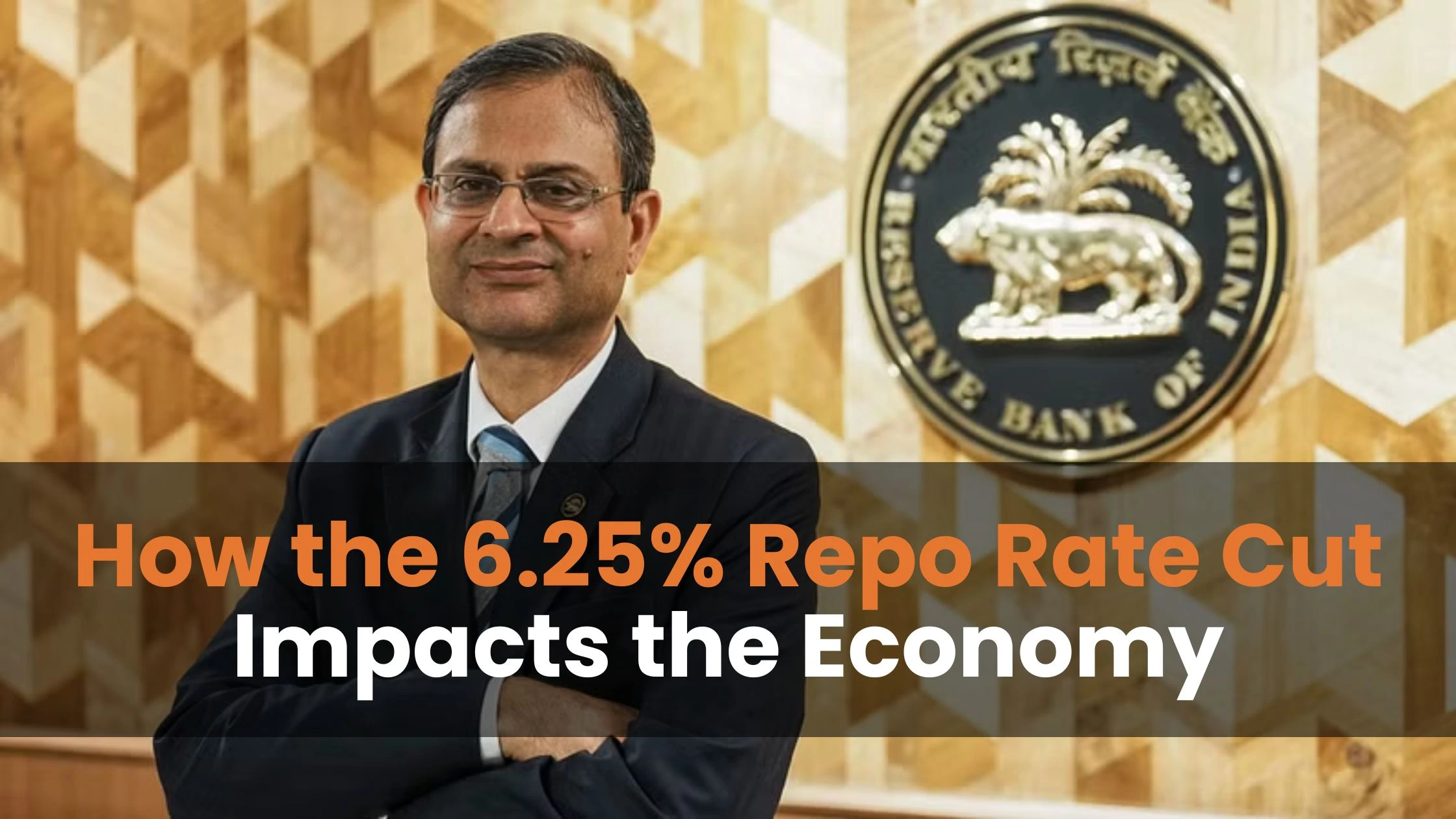Table of Content
In a significant announcement, RBI Governor Sanjay Malhotra revealed that the Monetary Policy Committee (MPC) has cut the benchmark repo rate by 25 basis points. This marks the first rate change since Malhotra took over in December 2024. Following the December 2024 MPC meeting that introduced a ₹1.16 trillion liquidity boost and a 50 basis point cut in the cash reserve ratio (CRR), the repo rate remained steady at 6.5%. This blog delves into the **repo rate & reverse repo rate 2025**, examining their effects on the economy, borrowers, and financial institutions. for 4 seconds
Malhotra announced a 25 basis point cut in the benchmark repo rate during the MPC’s three-day meeting that began on February 5, 2025 marking the first rate change since he took charge in December 2024 after Shaktikanta Das. Previously, in December 2024, the RBI boosted liquidity by ₹1.16 trillion through a 50 basis point CRR cut to 4%, while keeping the repo rate at 6.5%. This blog explores these key developments and their implications.
What Is the Repo Rate?
The repo rate is the interest rate at which the Reserve Bank of India (RBI) lends short-term funds to commercial banks. When banks face a shortage of funds, they sell securities to the RBI with an agreement to repurchase them at a later date. This transaction not only aids banks in managing their liquidity but also helps the central bank control inflation.
For a deeper insight into this financial tool, consider that understanding the dynamics behind the repo rate & reverse repo rate 2025 can empower stakeholders to anticipate policy changes and plan accordingly.
Also Read: Mumbai Metro 2025: Enhanced Routes, Stations & Real Estate Impact
Recent Developments in 2025
The year 2025 has brought significant changes in monetary policy, as reflected in recent decisions by the RBI’s Monetary Policy Committee (MPC). Notably, the RBI implemented a repo rate cut of 25 basis points, setting it at 6.25%, a historic move aimed at stimulating growth in a slowing economy. This decision has had far-reaching effects on various sectors, influencing borrowing costs and liquidity management across the board.
Such policy shifts underscore why keeping an eye on the repo rate & reverse repo rate 2025 is vital for understanding future economic trends and the central bank’s strategic outlook.
Economic Implications of the Rate Changes
The adjustments in repo and reverse repo rates have a direct impact on the overall economy. When the repo rate is lowered, banks can borrow money more cheaply, often passing on these benefits to consumers through reduced interest rates on loans and mortgages. This scenario is expected to boost spending and investment, fostering economic growth.
On the flip side, the reverse repo rate helps the RBI manage liquidity by incentivizing banks to park surplus funds with the central bank. This dual mechanism ensures that while credit remains accessible, inflation is kept in check. An informed grasp of the repo rate & reverse repo rate 2025 helps stakeholders understand how these policy tools balance growth with stability.
Impact on Borrowers and Financial Institutions
For borrowers, a reduction in the repo rate typically translates into lower loan interest rates, making it an opportune time to secure financing for homes, education, or business ventures. Financial institutions, meanwhile, benefit from the lowered cost of funds, which can lead to an expansion in credit availability. However, banks must also exercise caution to manage risks associated with increased lending.
A clear understanding of the repo rate & reverse repo rate 2025 not only assists individuals in making informed borrowing decisions but also enables banks to fine-tune their lending strategies in response to the evolving policy landscape.
Future Outlook: What to Expect
Looking ahead, the trajectory of the repo and reverse repo rates will likely continue to influence the broader economy. Analysts predict that the RBI may adopt further adjustments based on inflation trends and economic growth targets. This proactive approach ensures that monetary policy remains responsive to both domestic and global economic challenges.
Monitoring the developments around the repo rate & reverse repo rate 2025 will be crucial for investors, policymakers, and everyday consumers alike. Staying informed will enable stakeholders to anticipate market movements and align their financial strategies with future policy directions.
Key Takeaways
- Repo Rate Explained: It is the rate at which banks borrow funds from the RBI, affecting the cost of credit in the market.
- Reverse Repo Rate Explained: This rate is used by the RBI to absorb excess liquidity by borrowing from banks.
- 2025 Developments: A notable repo rate cut to 6.25% highlights the RBI’s efforts to stimulate growth amid economic challenges.
- Economic Impact: These changes influence inflation, consumer borrowing costs, and overall liquidity management.
- Looking Forward: Future policy adjustments are expected as the RBI navigates economic uncertainties.
For a concise summary of current trends, remember the phrase repo rate & reverse repo rate 2025 as it encapsulates the key elements of today’s monetary policy shifts.
Conclusion
In conclusion, the evolving landscape of monetary policy in India underscores the importance of understanding both the repo and reverse repo rates. The recent decisions made in 2025 have reinforced the critical role these rates play in balancing economic growth with inflation control. For anyone involved in financial planning, whether as a borrower, investor, or policy analyst, an informed perspective on the repo rate & reverse repo rate 2025 is indispensable. As the year unfolds, keeping track of these trends will not only help in making timely financial decisions but also in anticipating future policy directions.
Ultimately, this comprehensive guide on repo rate & reverse repo rate 2025 provides all you need to know about these pivotal financial instruments, offering clarity and insight in a complex economic environment.
Also Read: Save Tax by Paying Rent to Family? Here's What You Need to Know!







Ans 1. The repo rate is the interest rate at which RBI lends funds to commercial banks to manage liquidity.
Ans 2. A repo rate cut reduces borrowing costs, encouraging spending, investment, and economic growth.
Ans 3. The reverse repo rate is the rate at which RBI borrows funds from banks to absorb excess liquidity.
Ans 4. The RBI cut the repo rate to stimulate economic growth amid slowing indicators and control inflation.
Ans 5. A lower repo rate typically results in reduced interest rates on loans, benefiting borrowers.
Ans 6. Future repo rate decisions will depend on inflation trends and economic conditions.
Ans 7. The reverse repo rate encourages banks to park surplus funds with the RBI, helping control excess liquidity and inflation.
Ans 8. A lower repo rate reduces the cost of borrowing for banks, potentially leading to more accessible credit for consumers and businesses.